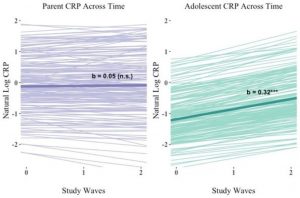Youth from socioeconomically disadvantaged backgrounds are at heightened risk for poorer physical and mental health, both during adolescence and into adulthood. Our lab examines how socioeconomic resources influence biological and behavioral factors, such as sleep and inflammation, to help us understand disparities in youth health.
INFLAMMATION IN PARENT-ADOLESCENT DYADS

Chronic inflammation is increasingly considered a marker of physical and mental health risk for both youth and adults. In a study published in Brain, Behavior, Immunity—Health, we measured changes in the pro-inflammatory marker, C-reactive protein (CRP), across a four-year period in a diverse sample of parent-adolescent pairs. We found that higher parental educational attainment was linked with lower CRP levels across the sample of parent-adolescent pairs. We also observed that parents’ CRP levels predicted their adolescents’ CRP at baseline, but not their change in CRP across time. While parent CRP remained relatively stable, adolescents showed a pattern of substantial inflammatory increase across the study period—highlighting adolescence as a potential target period for early risk detection and opportunity to modify behaviors that drive pro-inflammatory trajectories.
SLEEP AND CORTISOL ACROSS ADOLESCENCE
In another study published in Psychosomatic Medicine, we found that adolescents from families with fewer financial resources had shorter sleep duration. But interestingly, adolescents whose parents had higher educational attainment also had shorter sleep duration. Our analyses suggested that these sleep changes could be a consequence of altered secretion of cortisol—an important hormone that is released in line with ones’ sleep schedule and is reactive to perceived stressors. Future research in the lab will explore the specific daily experiences and demands that might place strains on sleep for youth across low and high socioeconomic environments.
CONCLUSION
Our research highlights sleep and inflammation as potential pathways by which family-level socioeconomic resources shape adolescent health. Findings emphasize the need to evaluate adolescent-specific experiences that contribute to the development of disparities in health and point to adolescence as a target period for intervention efforts seeking to offset future health risk.

